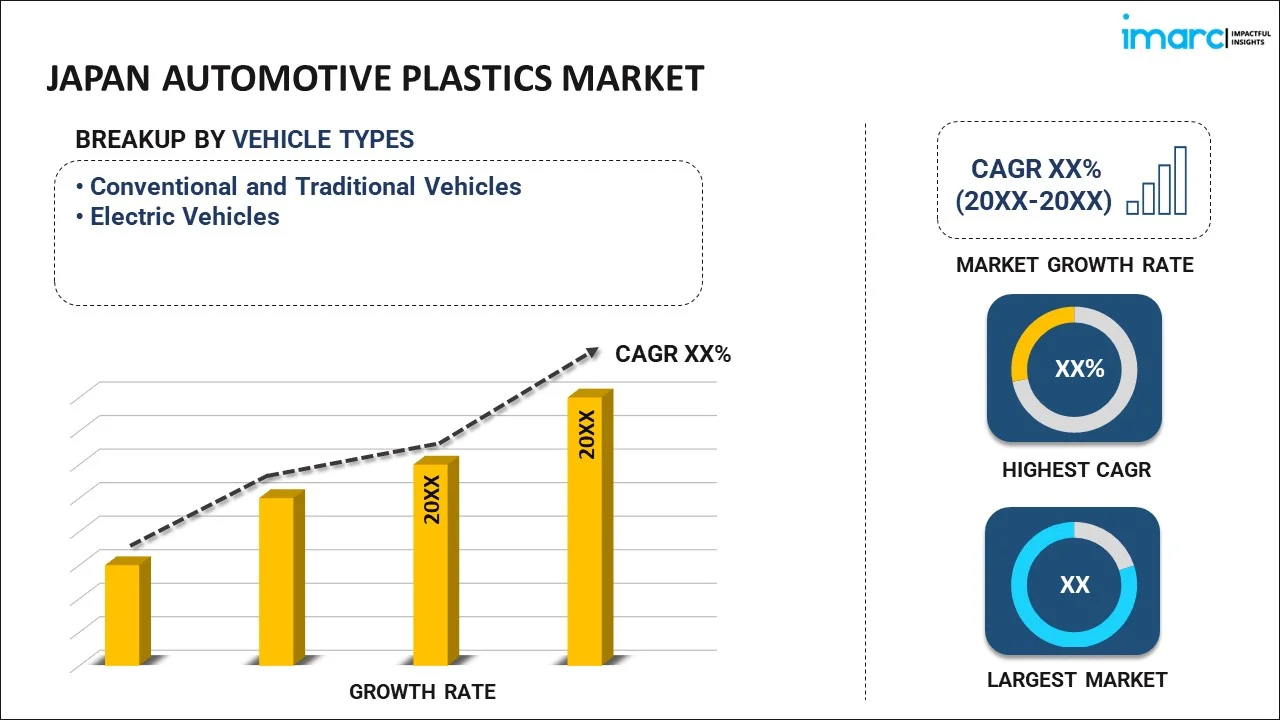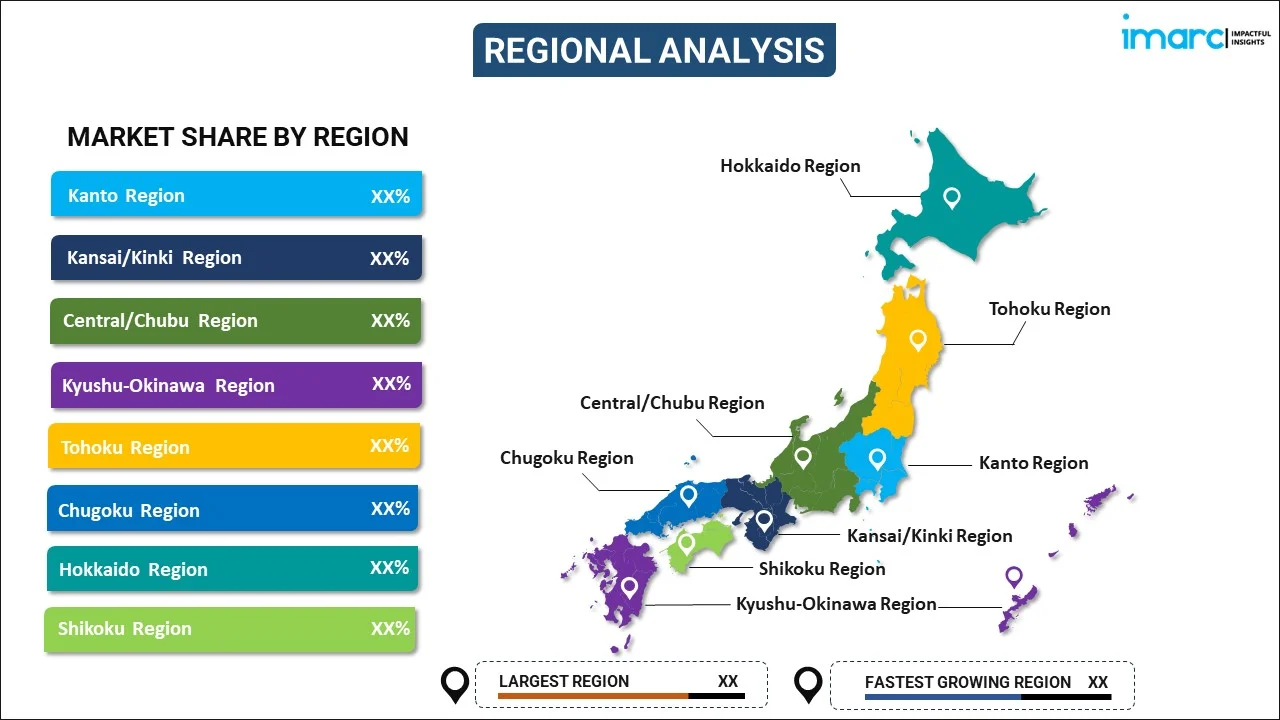
Japan Automotive Plastics Market Report by Vehicle Type (Conventional and Traditional Vehicles, Electric Vehicles), Material (Polyethylene (PE), Polypropylene (PP), Polyvinyl Chloride (PVC), Acrylonitrile Butadiene Styrene (ABS), Polyurethane (PU), Polymethyl Methacrylate (PMMA), Polycarbonate (PC), Polyamide, and Others), Application (Powertrain, Electrical Components, Interior Furnishings, Exterior Furnishings, Under the Hood, Chassis), and Region 2025-2033
Market Overview:
Japan automotive plastics market size reached USD 2.7 Billion in 2024. Looking forward, IMARC Group expects the market to reach USD 6.1 Billion by 2033, exhibiting a growth rate (CAGR) of 8.7% during 2025-2033. The rising adoption of electric and hybrid vehicles (EVs/HVs) is primarily driving the market growth.
|
Report Attribute
|
Key Statistics
|
|---|---|
|
Base Year
|
2024 |
|
Forecast Years
|
2025-2033
|
|
Historical Years
|
2019-2024
|
| Market Size in 2024 | USD 2.7 Billion |
| Market Forecast in 2033 | USD 6.1 Billion |
| Market Growth Rate (2025-2033) | 8.7% |
Automotive plastics usually encompass a range of materials, including polypropylene (PP), polyurethane (PU), polyvinyl chloride (PVC), acrylonitrile butadiene styrene (ABS), nylon, polyethylene (PE), polyoxymethylene (POM), and polycarbonate (PC). These materials play a crucial role in enhancing the longevity of automobiles, enhancing design adaptability, lowering production expenses, and simplifying component integration. Moreover, they also contribute to vehicle weight reduction by substituting heavier materials like metal and glass, thereby conserving energy and enhancing fuel efficiency.
Japan Automotive Plastics Market Trends:
The Japan automotive plastics market has emerged as a pivotal player in the automotive industry. Characterized by innovation and advanced technology, Japan's contribution to the development and utilization of automotive plastics cannot be overstated. Besides this, the market has witnessed exponential growth, driven by a confluence of factors. Japan's automotive manufacturers have been at the forefront of adopting plastic materials for various vehicle components, harnessing their lightweight properties and durability to improve fuel efficiency and reduce overall vehicle weight. This transition has not only aligned with the global trend towards eco-friendliness and sustainability but has also paved the way for groundbreaking automotive designs. Additionally, companies have consistently invested in cutting-edge research to develop high-performance plastics that meet the stringent safety and quality standards of the automotive industry. This commitment has led to the creation of a diverse range of plastic materials, such as polypropylene, polyurethane, and polycarbonate, which find extensive applications in automotive interiors, exteriors, and under-the-hood components. Furthermore, Japan's automotive plastics market has made significant strides in contributing to the circular economy, thereby acting as another significant growth-inducing factor. Apart from this, the emphasis on recycling and the development of recyclable plastic materials has not only reduced waste but also lowered the environmental footprint of the automotive sector, which is projected to fuel the regional market in the coming years.
Japan Automotive Plastics Market Segmentation:
IMARC Group provides an analysis of the key trends in each segment of the market, along with forecasts at the country level for 2025-2033. Our report has categorized the market based on vehicle type, material, and application.
Vehicle Type Insights:

- Conventional and Traditional Vehicles
- Electric Vehicles
The report has provided a detailed breakup and analysis of the market based on the vehicle type. This includes conventional and traditional vehicles and electric vehicles.
Material Insights:
- Polyethylene (PE)
- Polypropylene (PP)
- Polyvinyl Chloride (PVC)
- Acrylonitrile Butadiene Styrene (ABS)
- Polyurethane (PU)
- Polymethyl Methacrylate (PMMA)
- Polycarbonate (PC)
- Polyamide
- Others
A detailed breakup and analysis of the market based on the material have also been provided in the report. This includes polyethylene (PE), polypropylene (PP), polyvinyl chloride (PVC), acrylonitrile butadiene styrene (ABS), polyurethane (PU), polymethyl methacrylate (PMMA), polycarbonate (PC), polyamide, and others.
Application Insights:
- Powertrain
- Electrical Components
- Interior Furnishings
- Exterior Furnishings
- Under the Hood
- Chassis
The report has provided a detailed breakup and analysis of the market based on the application. This includes powertrain, electrical components, interior furnishings, exterior furnishings, under the hood, and chassis.
Regional Insights:

- Kanto Region
- Kansai/Kinki Region
- Central/ Chubu Region
- Kyushu-Okinawa Region
- Tohoku Region
- Chugoku Region
- Hokkaido Region
- Shikoku Region
The report has also provided a comprehensive analysis of all the major regional markets, which include Kanto Region, Kansai/Kinki Region, Central/ Chubu Region, Kyushu-Okinawa Region, Tohoku Region, Chugoku Region, Hokkaido Region, and Shikoku Region.
Competitive Landscape:
The market research report has also provided a comprehensive analysis of the competitive landscape. Competitive analysis such as market structure, key player positioning, top winning strategies, competitive dashboard, and company evaluation quadrant has been covered in the report. Also, detailed profiles of all major companies have been provided.
Japan Automotive Plastics Market Report Coverage:
| Report Features | Details |
|---|---|
| Base Year of the Analysis | 2024 |
| Historical Period | 2019-2024 |
| Forecast Period | 2025-2033 |
| Units | Billion USD |
| Scope of the Report | Exploration of Historical Trends and Market Outlook, Industry Catalysts and Challenges, Segment-Wise Historical and Future Market Assessment:
|
| Vehicle Types Covered | Conventional and Traditional Vehicles, Electric Vehicles |
| Materials Covered | Polyethylene (PE), Polypropylene (PP), Polyvinyl Chloride (PVC), Acrylonitrile Butadiene Styrene (ABS), Polyurethane (PU), Polymethyl Methacrylate (PMMA), Polycarbonate (PC), Polyamide, Others |
| Applications Covered | Powertrain, Electrical Components, Interior Furnishings, Exterior Furnishings, Under the Hood, Chassis |
| Regions Covered | Kanto Region, Kansai/Kinki Region, Central/ Chubu Region, Kyushu-Okinawa Region, Tohoku Region, Chugoku Region, Hokkaido Region, Shikoku Region |
| Customization Scope | 10% Free Customization |
| Post-Sale Analyst Support | 10-12 Weeks |
| Delivery Format | PDF and Excel through Email (We can also provide the editable version of the report in PPT/Word format on special request) |
Key Questions Answered in This Report:
- How has the Japan automotive plastics market performed so far and how will it perform in the coming years?
- What has been the impact of COVID-19 on the Japan automotive plastics market?
- What is the breakup of the Japan automotive plastics market on the basis of vehicle type?
- What is the breakup of the Japan automotive plastics market on the basis of material?
- What is the breakup of the Japan automotive plastics market on the basis of application?
- What are the various stages in the value chain of the Japan automotive plastics market?
- What are the key driving factors and challenges in the Japan automotive plastics?
- What is the structure of the Japan automotive plastics market and who are the key players?
- What is the degree of competition in the Japan automotive plastics market?
Key Benefits for Stakeholders:
- IMARC’s industry report offers a comprehensive quantitative analysis of various market segments, historical and current market trends, market forecasts, and dynamics of the Japan automotive plastics market from 2019-2033.
- The research report provides the latest information on the market drivers, challenges, and opportunities in the Japan automotive plastics market.
- Porter's five forces analysis assist stakeholders in assessing the impact of new entrants, competitive rivalry, supplier power, buyer power, and the threat of substitution. It helps stakeholders to analyze the level of competition within the Japan automotive plastics industry and its attractiveness.
- Competitive landscape allows stakeholders to understand their competitive environment and provides an insight into the current positions of key players in the market.
Need more help?
- Speak to our experienced analysts for insights on the current market scenarios.
- Include additional segments and countries to customize the report as per your requirement.
- Gain an unparalleled competitive advantage in your domain by understanding how to utilize the report and positively impacting your operations and revenue.
- For further assistance, please connect with our analysts.
 Inquire Before Buying
Inquire Before Buying
 Speak to an Analyst
Speak to an Analyst
 Request Brochure
Request Brochure
 Request Customization
Request Customization




.webp)




.webp)












